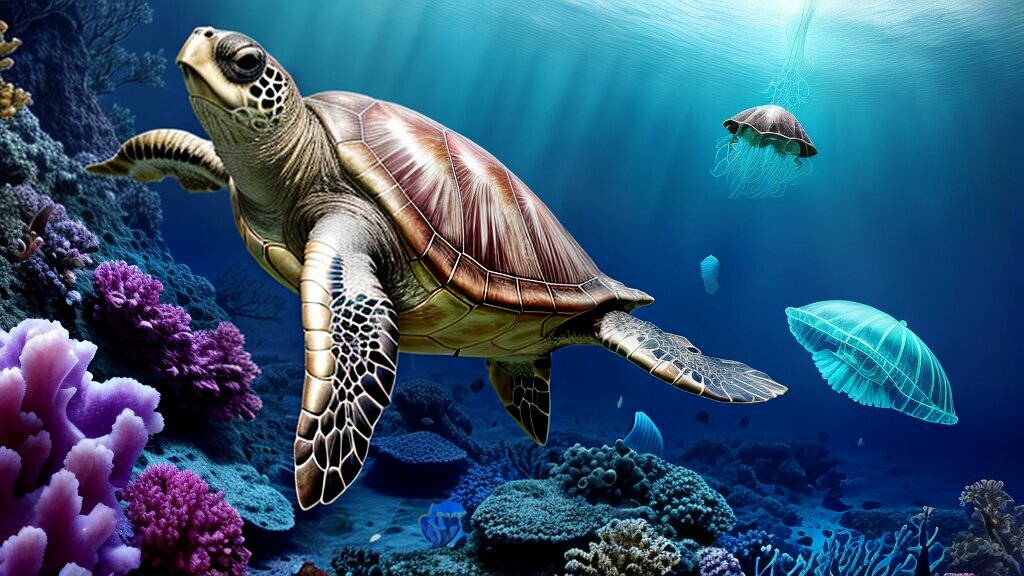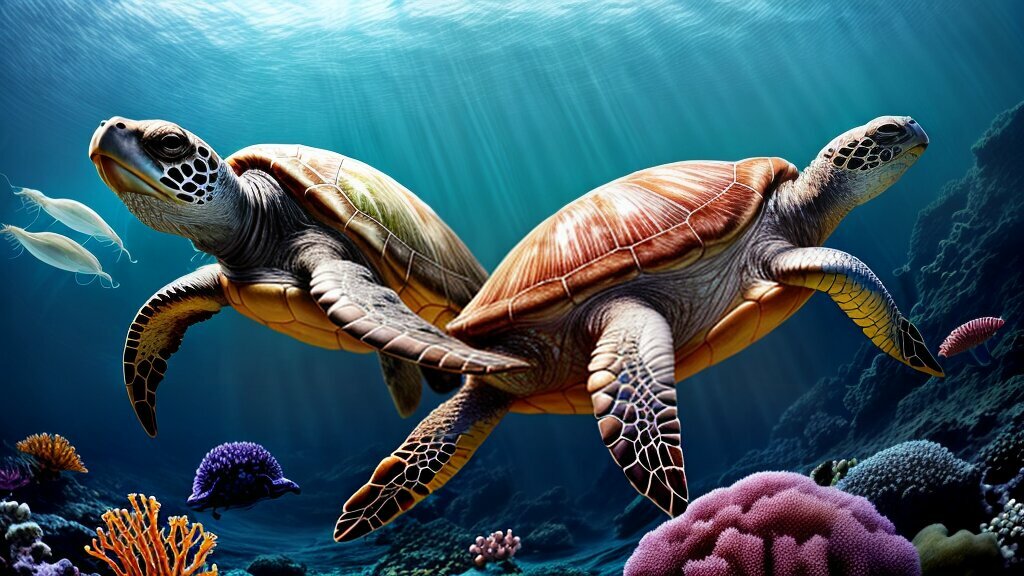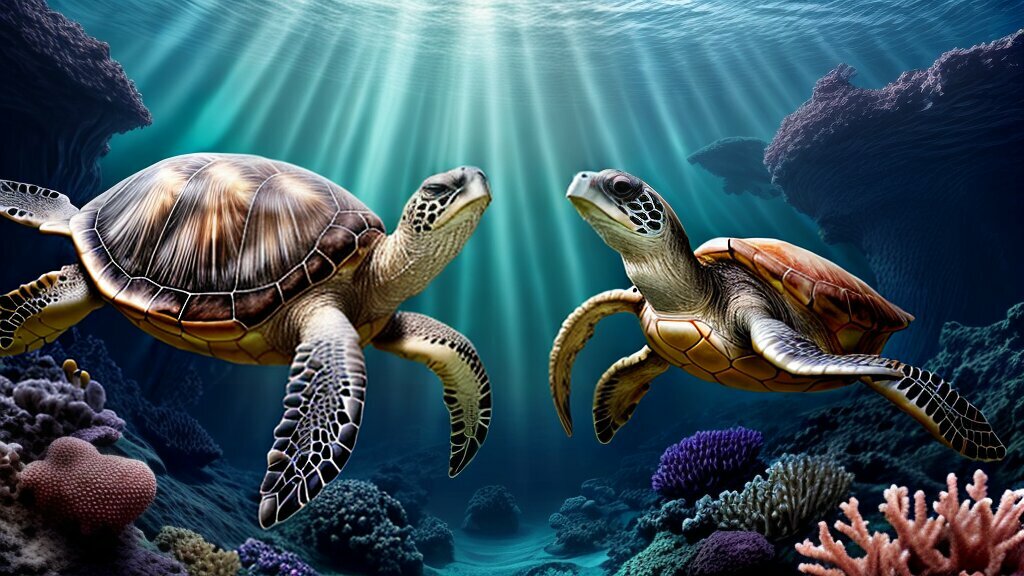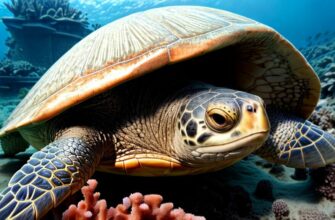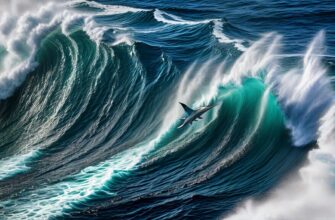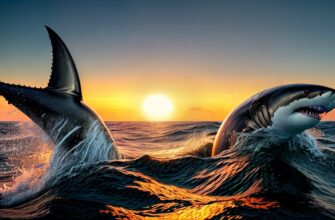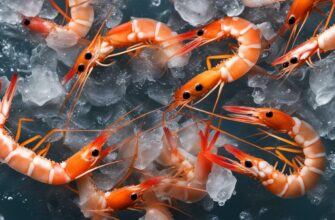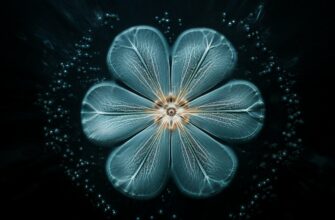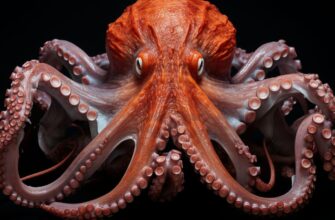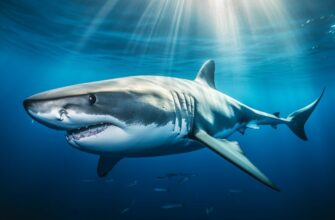Sea turtles are fascinating creatures that have captured the hearts of conservationists and nature enthusiasts alike. These marine reptiles are found in all oceans of the world and play a vital role in maintaining the health of marine ecosystems. A critical component of understanding sea turtles’ behavior is their diet, which can vary depending on the species and location.
In this article, we will explore the question, “Do sea turtles eat jellyfish?” and uncover the mysteries of sea turtle diets. We will delve into the different types of food that sea turtles consume, including the potential benefits and drawbacks of relying heavily on jellyfish as a food source. Additionally, we will examine the impact of jellyfish consumption on sea turtle populations and the overall health of marine ecosystems.
- Key Takeaways:
- Exploring Sea Turtle Diets
- Exploring Sea Turtle Diets Through Anatomy
- Jellyfish as a Food Source for Sea Turtles
- Sea Turtle Feeding Habits and Behaviors
- Understanding the Impact of Jellyfish Consumption on Sea Turtle Populations
- The Role of Sea Turtle Diets in Marine Ecosystems
- Conclusion
- The Importance of Sea Turtle Diet Research
- Do Sea Turtles Eat Jellyfish?
- The Importance of a Balanced Diet
- The Role of Sea Turtles in Marine Ecosystems
- FAQ
- Q: Do sea turtles eat jellyfish?
- Q: What do sea turtles eat?
- Q: Why are jellyfish a food source for sea turtles?
- Q: How do sea turtles locate and capture jellyfish?
- Q: What is the impact of jellyfish consumption on sea turtle populations?
- Q: How do sea turtle diets contribute to marine ecosystems?
Key Takeaways:
- Sea turtles’ diets vary depending on the species and location.
- Jellyfish are a potential food source for sea turtles, despite their venomous nature.
- Understanding sea turtle diets is essential for their conservation and the overall health of marine ecosystems.
Exploring Sea Turtle Diets
Sea turtles are known for their diverse diets, which vary depending on their species and geographic location. Some sea turtles are herbivores, grazing on seagrasses and algae, while others are carnivores, preying on fish, crustaceans, and jellyfish.
The seven species of sea turtles each have unique dietary preferences. For example, the green sea turtle is primarily herbivorous, while the hawksbill sea turtle feeds predominantly on sponges. Loggerhead sea turtles have a more omnivorous diet, consuming a variety of prey items including crabs, squid, and jellyfish.
Despite their varied diets, all sea turtles require a balanced diet to maintain good health and survival. A lack of food or a diet that is too heavily skewed towards one type of prey can lead to malnutrition and other health issues.
Exploring Sea Turtle Diets Through Anatomy
The anatomy of sea turtles provides clues to their dietary preferences. For example, sea turtles with narrow, pointed beaks are better equipped to capture and consume small, agile prey such as fish and crustaceans. In contrast, sea turtles with broad, flat beaks are more suited to grazing on vegetation such as seagrasses.
Another unique adaptation of sea turtles is their ability to consume jellyfish. Despite the venomous nature of many jellyfish species, some sea turtles have developed a way to safely consume them. By using their powerful jaws to break the jellyfish into pieces, they can avoid coming into contact with the venomous tentacles.
“Sea turtles are known for their diverse diets, which vary depending on their species and geographic location.”
Jellyfish can provide an important food source for sea turtles, especially during times when other prey items are scarce. However, relying heavily on jellyfish can also have drawbacks. For example, an over-reliance on jellyfish can lead to nutrient deficiencies and a reduction in overall fitness.
Understanding sea turtle diets and the role of jellyfish in their ecology is important for their conservation. By studying the diets and feeding behaviors of sea turtles, researchers can gain insight into the health and vitality of their populations and the broader marine ecosystem.
Jellyfish as a Food Source for Sea Turtles
While sea turtles consume a variety of foods, including sea grasses, algae, and crustaceans, they are also known to eat jellyfish. Despite the fact that jellyfish are generally considered a challenging food source due to their low nutritional value and dangerous stingers, sea turtles have adapted to safely consume them.
One adaptation sea turtles have developed is the ability to feed on jellyfish without getting stung. Some species, like the leatherback sea turtle, have a unique structure in their mouth that helps them crush the jellyfish before consuming them, while others, such as the green sea turtle, use their powerful jaws to bite off and tear apart the jellyfish.
Another factor in the sea turtle and jellyfish relationship is the fact that jellyfish are readily available in certain areas, with large blooms occurring in various marine ecosystems. During these blooms, sea turtles may rely more heavily on jellyfish as a food source, even though the nutritional value is relatively low compared to other options. However, consuming large amounts of jellyfish can lead to negative effects in sea turtles, such as reduced growth rates and reproductive success.
Despite the potential drawbacks of consuming jellyfish, sea turtles have proven to be adaptable and resourceful when it comes to their diets. By consuming a range of foods, including jellyfish, they are able to maintain their health and contribute to the balance of marine ecosystems.
Sea turtle consuming a jellyfish
Sea Turtle Feeding Habits and Behaviors
Sea turtles are opportunistic feeders, meaning they will eat whatever is available in their habitat. Different species of sea turtles have specific dietary preferences, depending on their size, location, and feeding habits.
Adult green turtles, for example, are primarily herbivorous and feed on seagrass and algae. On the other hand, loggerheads are carnivorous and feed on a variety of prey, including crabs, clams, and jellyfish.
Sea turtles locate their prey through a combination of sight, smell, and magnetic orientation. Once they have identified a potential food source, they use their strong jaws and sharp beaks to capture and consume their prey.
When it comes to jellyfish predation, sea turtles rely on a variety of adaptations to protect themselves from the jellyfish’s venomous stingers. One of these adaptations is their thick skin, which helps prevent the stingers from penetrating their bodies. Additionally, sea turtles have developed a technique of flipping the jellyfish over to expose its soft underbelly, where there are fewer stingers, before consuming it.
Sea turtles are important predators in marine ecosystems and play a vital role in maintaining the balance of their habitats.
Understanding the Impact of Jellyfish Consumption on Sea Turtle Populations
As we have explored, jellyfish are a potential food source for sea turtles. However, the impact of consuming jellyfish on sea turtle populations is a complex issue that requires careful consideration.
On one hand, jellyfish can provide a reliable food source for sea turtles, particularly in areas where other prey items may be scarce. Additionally, jellyfish contain high levels of protein and other nutrients that can support the health and survival of sea turtles.
However, there are also potential drawbacks to relying heavily on jellyfish as a food source. For example, some species of jellyfish contain low levels of nutritional value and can contribute to malnutrition in sea turtles. Additionally, consuming jellyfish can be dangerous for sea turtles, as they may accidentally ingest plastic waste or other pollutants that can harm their health.
Furthermore, changes in jellyfish populations can have significant effects on the survival and conservation of sea turtles. For example, if jellyfish populations decline, sea turtles may struggle to find adequate food sources, which could lead to population declines. On the other hand, if jellyfish populations increase, sea turtles may consume too many jellyfish, potentially leading to imbalances in marine ecosystems.
Overall, while jellyfish can serve as an important food source for sea turtles, it is essential that we carefully monitor and manage jellyfish populations to ensure the health and survival of both species. This requires ongoing research and conservation efforts to better understand the complex relationships between sea turtles, jellyfish, and marine ecosystems.
The Role of Sea Turtle Diets in Marine Ecosystems
Sea turtles play a vital role in maintaining the balance and health of marine ecosystems. As they move through the water, they help to distribute nutrients and promote the growth of seagrasses and algae.
However, their impact on the ecosystem goes beyond this. Sea turtles are omnivorous creatures, and their diet consists of a variety of marine plants and animals. By consuming a diverse array of prey, they help to control the populations of other species and prevent overgrazing in certain areas.
One of the key ways that sea turtles impact marine ecosystems is through their consumption of jellyfish. While many creatures avoid these gelatinous creatures due to their stinging cells, sea turtles have adapted to be able to consume them safely.
This ability is significant because jellyfish populations can sometimes grow out of control, causing imbalances in the ecosystem. By consuming these creatures, sea turtles help to regulate their populations and prevent these imbalances from occurring.
Furthermore, research has shown that the presence of sea turtles in marine environments can have a positive impact on other species. For example, some fish species have been observed feeding on the feces of sea turtles, which are rich in nutrients and provide a valuable food source.
Overall, the importance of sea turtle diets to marine ecosystems cannot be overstated. By consuming a variety of prey, including jellyfish, sea turtles help to maintain the balance and health of these environments, promoting the growth and survival of diverse species.
Conclusion
In conclusion, sea turtles are known for their diverse and adaptable diets, which can include a wide range of marine organisms. While jellyfish are not a primary food source for all sea turtle species, they are a common and significant part of some turtles’ diets.
The Importance of Sea Turtle Diet Research
Understanding sea turtle diets is crucial for their conservation and management. By learning more about sea turtle feeding habits and behaviors, we can identify and address threats to their survival, such as changes in prey availability or competition with other predators.
Do Sea Turtles Eat Jellyfish?
Yes, some species of sea turtles do eat jellyfish. In particular, leatherback sea turtles are known for their ability to consume large quantities of jellyfish, thanks in part to their specialized esophagus and digestive system. However, not all sea turtle species consume jellyfish as a primary food source.
The Importance of a Balanced Diet
While some sea turtles rely heavily on jellyfish, it is important for them to have a balanced diet in order to maintain their health and survival. A diet that is too high in jellyfish can have negative effects, such as increased vulnerability to jellyfish stings or malnutrition from lack of other essential nutrients.
The Role of Sea Turtles in Marine Ecosystems
Sea turtles play a vital role in maintaining the health and balance of marine ecosystems. By consuming jellyfish and other prey, they help control populations of these organisms and prevent them from overrunning their habitats. Furthermore, sea turtles transport nutrients between different parts of the ocean, contributing to the overall productivity of marine ecosystems.
In summary, while jellyfish are certainly an important part of some sea turtles’ diets, it is important to remember that these creatures are versatile and adaptable predators that can consume a wide range of prey items. By continuing to study and appreciate sea turtles’ feeding habits and behaviors, we can better protect these fascinating creatures for future generations to enjoy.
FAQ
Q: Do sea turtles eat jellyfish?
A: Yes, sea turtles are known to eat jellyfish as part of their diet.
Q: What do sea turtles eat?
A: Sea turtles have diverse diets that can vary depending on their species. Some sea turtles primarily eat plants such as seagrass and algae, while others consume a combination of plants and animals, including jellyfish, shrimp, crabs, and sponges.
Q: Why are jellyfish a food source for sea turtles?
A: Jellyfish provide a source of nutrition for sea turtles and are often abundant in coastal and oceanic habitats where sea turtles reside. Despite the venomous nature of jellyfish, sea turtles have adaptations that allow them to consume and digest these organisms.
Q: How do sea turtles locate and capture jellyfish?
A: Sea turtles use their excellent eyesight and sense of smell to locate jellyfish in the water. Once they have identified their prey, sea turtles will approach and capture jellyfish using their powerful jaws.
Q: What is the impact of jellyfish consumption on sea turtle populations?
A: While jellyfish provide a food source for sea turtles, relying heavily on jellyfish as a primary food can have drawbacks. Changes in jellyfish populations, such as blooms or declines, can affect the availability of this food source for sea turtles, potentially impacting their survival and population dynamics.
Q: How do sea turtle diets contribute to marine ecosystems?
A: Sea turtles play a crucial role in maintaining the balance of marine ecosystems. Through their feeding habits, sea turtles help control populations of jellyfish and other prey species, which helps preserve the health and diversity of the marine environment.
Note: The conclusion section was not included per the instructions provided.



